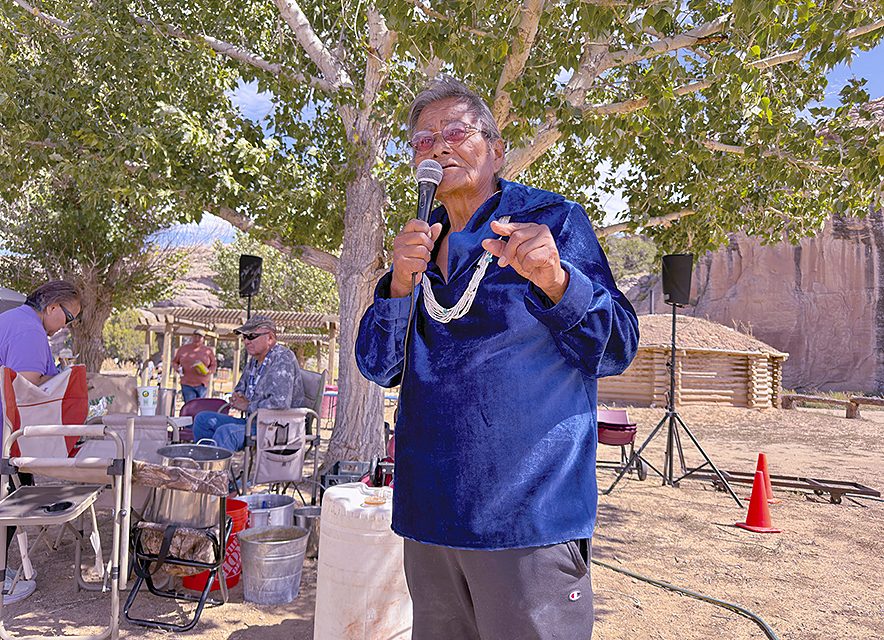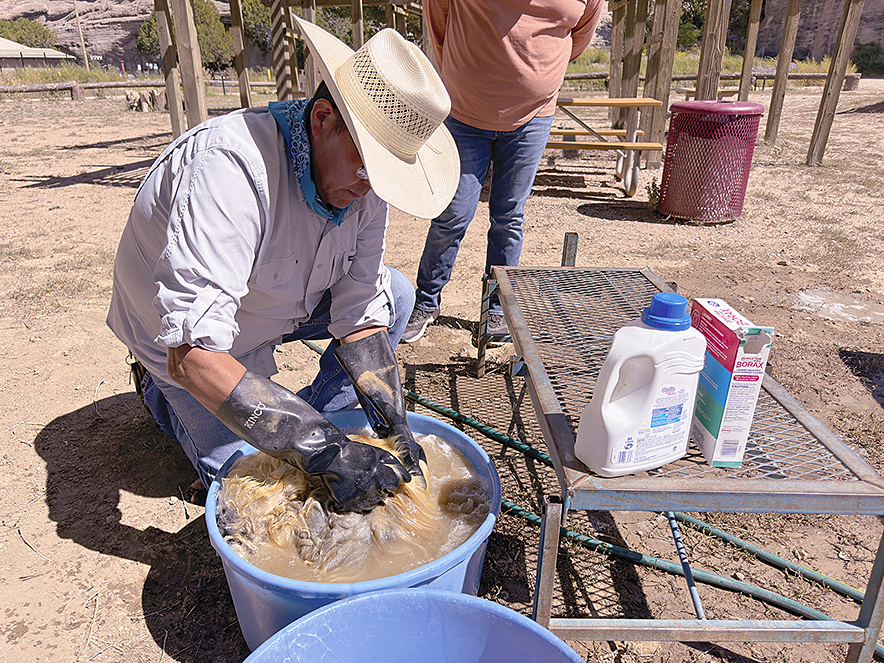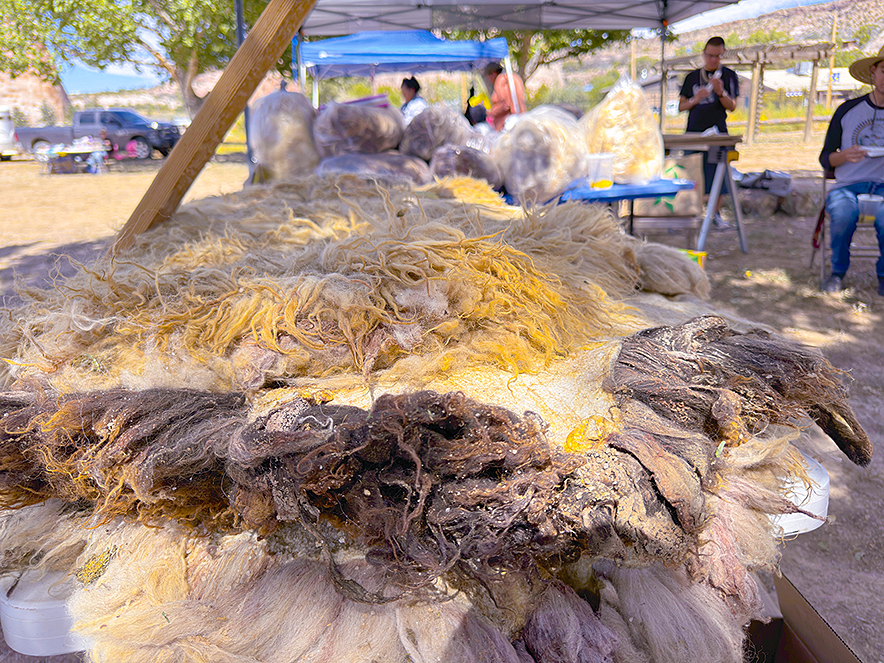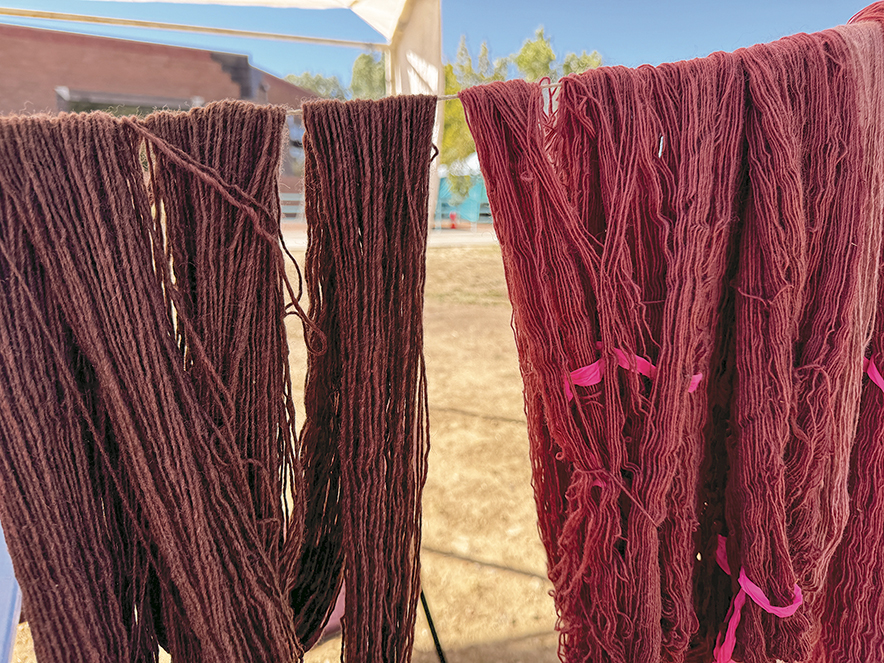
‘We can’t lose it’: 28th Annual Sheep is Life highlights the importance of sheep

Navajo Times | Nicholas House
Ron Garnanez, the vice president of Dibé Bé’Iiná Inc., lectures on the topic of “Sheep to Table” Sept. 21 in Window Rock. Sheep to Table is a Diné Bé'Iiná program that teaches people how to raise sheep and be mindful.
By Tyson Hudson
Navajo Times
WINDOW ROCK – It’s fall, and wool is in the air at the Navajo Nation Museum.

Navajo Times | Nicholas House
Jay Begay, a tanning hide demonstrator from Hard Rock, N.M., soaks a hide before tanning Sept. 21 outside the Navajo Nation Museum. This is one of many steps in the sheepskin tanning process.
Sheep and their significance to the Navajo way of life were showcased at the museum through presentations, demonstrations, and vendors selling their wares on Friday and Saturday.
Despite the wind, dozens of people watched different presentations about how sheep and their wool are used for food, clothing, and warmth.
Ron Garnanez, the vice president of Diné Bé’Iiná Inc., a sheep rancher and traditional practitioner from Tsé Ch’il Yaa Tó, Arizona, presented. He and Gloria Begay, a weaver from Navajo, New Mexico, and a Diné Bé’Iiná board member, co-sponsored the event in conjunction with the Navajo Nation Museum and Weaving In Beauty.
Garnanez was happy that many people showed up on a Friday to catch his afternoon presentation on how sheep are used. Part of his presentation talked about how to butcher a sheep properly.

Navajo Times | Nicholas House
An example of a finished tanned hide. It is cured with pig brain smeared onto the tan during the 28th Annual Sheep is Life event at the Navajo Nation Museum on Sept. 21.
Garnanez said the organization provides information about how Navajo tradition is applied to gardening and taking care of sheep. He hopes the presentations he shared with the younger generation will keep these methods going.
“This is what our ancestors left us with,” Garnanez said. “We can’t lose it.”
Sheep provides Diné with security, comfort, health, food, clothing, and education, Garnanez said. They also teach Diné how to interact with animals.
Vendors, presenters connect with culture
Tasha Nez came up from Ramah, New Mexico, to sell her paintings and earrings at the event. She was at the Sheep Is Life event last year.
Nez liked the presentations about weaving. She believes the current technology disconnects the younger Diné from their local environment.
Events like this help connect them with their own culture and understand where they come from, said Nez.
Jaynie Parrish, the executive director of Arizona Native Vote, said sheep are important to the Navajo way of life because they are a symbol of sovereignty and a foundation in which Diné provide for themselves.
Much abundance comes from everything about the sheep, Parrish said from her booth that checked the voter registration status of Diné residents.
Visitors absorbing teachings
Ruben Brock, a visitor from Phoenix, has attended Sheep Is Life off and on since 2017. He said sheep illustrate the resiliency of Navajo culture because the Diné adopted the sheep after European contact and absorbed them into their culture.

Navajo Times | Nicholas House
Spun wool dries after being dyed with natural plants at the 28th Annual Sheep is Life event outside the Navajo Nation Museum in Window Rock on Sept. 21.
Garnanez said sheep kept Navajo ancestors going for so many years that a distinct breed, the Navajo-Churro, developed here. He teaches that sheep husbandry in the Navajo Nation is in danger of becoming extinct.
Alvis Burbank, a National Park Service ranger at Hubbell Trading Post, said Diné are still sheep people.
Burbank said the trading post has a working ranch with Churro, and the park service still conducts big events involving sheep.
NPS Ranger Lashanna Deschine believes sheep are important for weaving and it helps keep the tradition alive.
There are more opportunities to attend workshops like Sheep Is Life, said Deschine. She mentioned making a woolen sash belt for her daughter.
Sheep are the future, Garnanez added. They teach one how to live in harmony with family and neighbors.
After the Friday event came to a close, Garnanez turned his attention to a young Diné man, with a shaved head and dressed in skater gear, who was making a wool thread with a European-style spinning wheel.
“It’s really nice when the younger generation shows their interest,” Garnanez said.








 Highway 264,
Highway 264, I-40, WB @ Winslow
I-40, WB @ Winslow